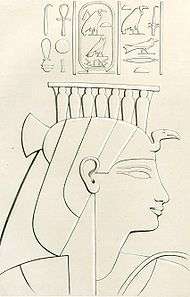Mutemwiya
Mutemwiya (also written as Mutemwia, Mutemuya or Mutemweya) was a minor wife of the Eighteenth Dynasty pharaoh Thutmose IV, and the mother of Pharaoh Amenhotep III. Mutemwiya's name means "Mut in the divine bark".[1]
| Mutemwiya in hieroglyphs | ||||||||||||
|---|---|---|---|---|---|---|---|---|---|---|---|---|
Mutemwia (Mut em wia) Mwt m wiA Mut in the divine barque | ||||||||||||
 | ||||||||||||
Mutemwiya | |
|---|---|
| Other names | Mutemwia, Mutemuya, Mutemweya |
| Occupation | Queen of Egypt |
| Spouse(s) | Thutmose IV |
| Children | Amenhotep III |
| Relatives | Akhenaten (grandson) |

Biography
Mutemwiya is not attested during the reign of her husband Thutmose IV. She would have been overshadowed at court by the chief queens Nefertari, and later Iaret. Mutemwiya is only shown on the monuments of her son Amenhotep III.[2]
While she occasionally was identified by some researchers as a daughter of King Artatama I of Mitanni, no evidence proves that she is the same person, and nothing about her own background is known.[3] There seemed to be evidence that she was not a daughter of Artatama,[4] but this theory has been discarded.[5] Cyril Aldred has suggested that Mutemwiya be a sister of Yuya.[6] He argues that since Mutemwiya was present during the early years of her son's reign, she might have engineered the marriage between Tiye and the young king to connect her family with royalty. However, this theory is poorly supported by texts or archaeological finds.
Mutemwiya held many titles including God’s Wife (Hm.t-nTr), Lady of The Two Lands (nb.t-tAwy), Great King’s Wife, his beloved (Hm.t-nsw-wr.t mry.t=f), noblewoman, countess (r.t-pa.t), Great of Praises (wr.t-Hsw.t), Sweet of Love (bnr.t-mrw.t), Mistress of Upper and Lower Egypt (Hnw.t-rsy-mHw), and God's Mother (mwt-nTr).[7] The titles king's mother and god's mother amount to the same thing since the god in question was the reigning king, Amenhotep III.[8] All of these titles, including that of Great Royal Wife, were used only after her husband's death, during her son's reign. At the time of Amenhotep III’s accession to the throne she gained prominence as the new pharaoh's mother.[9]
Mutemwiya is shown in the Luxor temple, in scenes depicting the divine birth of her son Amenhotep III. The scenes resemble (and in some cases copy) scenes of the divine birth of Hatshepsut in Deir el-Bahari. Hatshepsut had used the birth story to reinforce her claims to the throne. Amenhotep was the son of a ruling Pharaoh and it seems that the birth scene is used to stress the semi-divine nature of Amenhotep III. In a key scene Mutemwiya is shown seated on a bed receiving the god Amun who had taken the form of her husband Thutmosis IV. They are in the presence of the goddesses Selket and Neith. The scenes show Amenhotep III to be the result of the union of his mother with the god Amun himself.[5][9] A pregnant queen Mutemwiya as later shown being led to the birthing room by Isis and Khnum.[6]
A partial granite statue representing Mutemwiya was found in Karnak and it now is in the collection of the British Museum. The statue takes the form of a rebus showing the goddess Mut seated in a barque, thereby forming her name. Mutemwiya is named in the inscription on the side of the barque.[9][10]
Along with her daughter-in-law, Tiye, she also is shown on the Colossi of Memnon erected by Amenhotep III.[2][5]
Death
The date of Mutemwiya's death is unknown, but she is believed to have survived long into her son's reign. The evidence for that is her presence among the sculptures of the Colossi of Memnon, which was built well into his reign, as well as a mention of her estate on a wine-jar label found in Amenhotep III's Malkata palace in Thebes.[5]
References
- Ranke, Hermann (1935). Die Ägyptischen Personennamen, Bd. 1: Verzeichnis der Namen. Glückstadt: J.J. Augustin. p. 147.
- Aidan Dodson & Dyan Hilton, The Complete Royal Families of Ancient Egypt, Thames & Hudson (2004), pp. 132-141.
- Betsy Bryan, The Reign of Thutmose IV, (Johns Hopkins University Press: 1991), p.119
- Nicolas Grimal, A History of Ancient Egypt, (Blackwell Books: 1992), p.221
- O'Connor, David and Cline, Eric H. Amenhotep III: Perspectives on His Reign University of Michigan Press. 2001 ISBN 978-0-472-08833-1
- Aldred, Cyril, Akhenaten: King of Egypt ,Thames and Hudson, 1991 (paperback). ISBN 0-500-27621-8
- Grajetzki, Ancient Egyptian Queens: A Hieroglyphic Dictionary, Golden House Publications, London, 2005, ISBN 978-0-9547218-9-3
- Betsy Bryan, Chapter 6: "Thutmose IV Abroad and at Home" in 'The Reign of Thutmose IV,' pp.113-118
- Tyldesley, Joyce. Chronicle of the Queens of Egypt. Thames & Hudson. 2006, p. 114. ISBN 0-500-05145-3
- Quirke, Stephen and Spencer, Jeffrey, The British Museum Book of Ancient Egypt, Thames and Hudson, 1992, p 78. ISBN 0-500-27902-0
See also
- Eighteenth dynasty of Egypt Family Tree